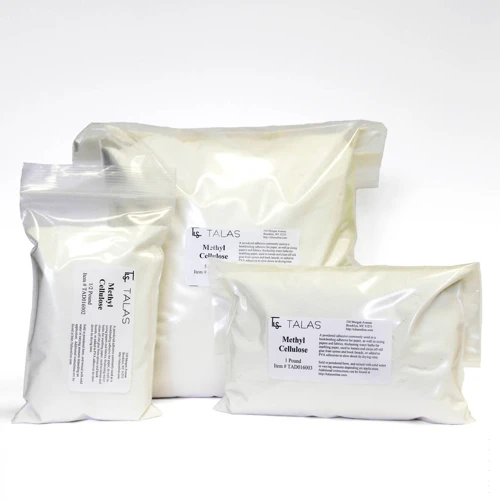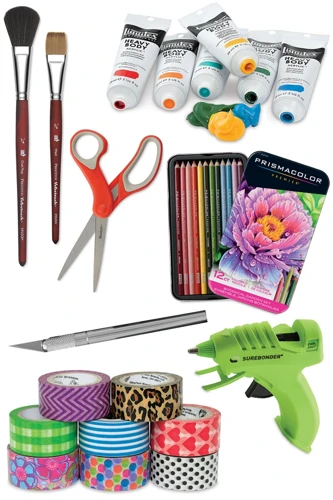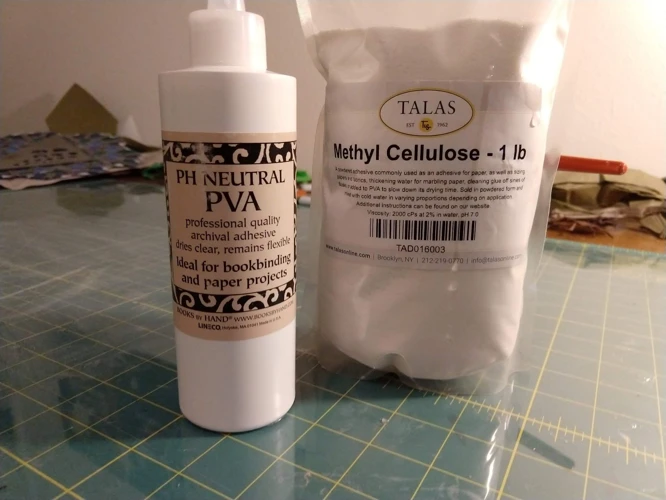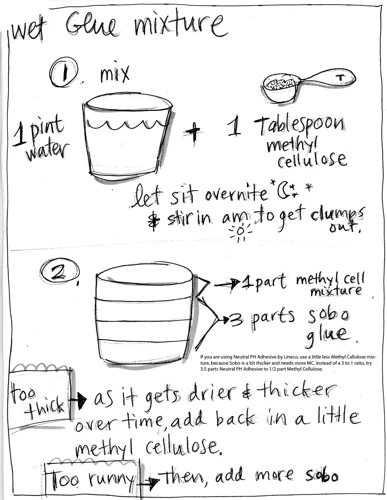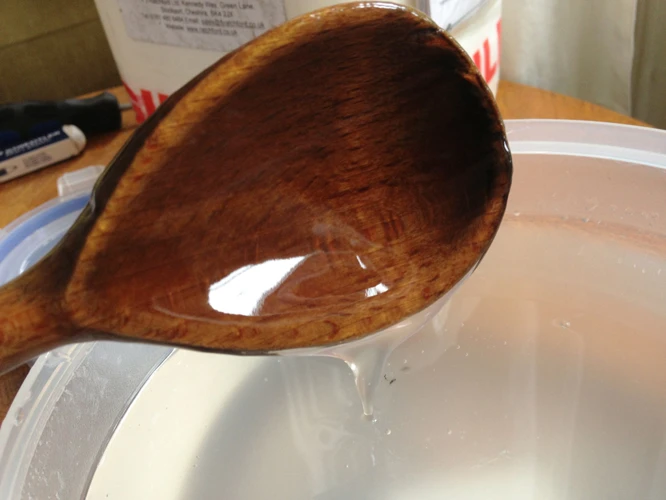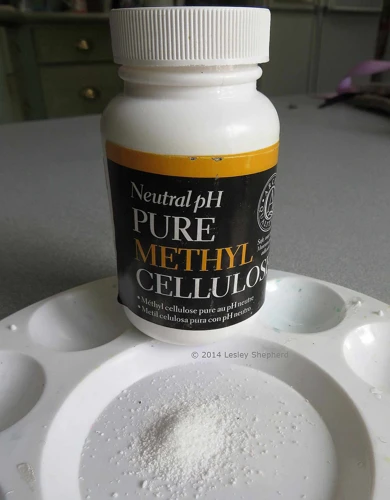Crafting can be a fun and rewarding pastime, whether it involves woodworking, paper art, or any other type of DIY project. However, choosing the right adhesive is crucial to ensure a long-lasting outcome. One of the lesser-known options is methyl cellulose glue, which can be a great alternative to more common options like PVA glue or hot glue. This guide will walk you through the step-by-step process of making your own methyl cellulose glue, as well as discussing the pros and cons of this type of adhesive. So let’s roll up our sleeves and get started!
What is Methyl Cellulose Glue?
Methyl Cellulose glue is a water-soluble adhesive that is made from plant cellulose. It is commonly used in art and craft applications as well as in the restoration of antique books and documents.
Methyl Cellulose glue is a non-toxic, odorless, and neutral pH adhesive. It is made by dissolving methyl cellulose powder in water to create a sticky, paste-like substance. It is considered to be a non-permanent adhesive, as it can be easily removed with water, making it a great choice for temporary fixes.
Methyl Cellulose glue has a wide range of applications. It is commonly used in bookbinding and paper conservation as it has a high degree of reversibility, meaning it can be removed without causing damage to the paper or book. It is also used in the preservation of paintings and other artworks.
In addition to its use in art restoration, Methyl Cellulose glue is also popular in the DIY community. It is commonly used in the creation of slime, a popular children’s toy, and in the creation of butter slime, a variation of slime that has a smooth and buttery texture.
Methyl Cellulose glue is a versatile adhesive that can be used in a variety of applications, from art restoration to DIY projects.
What Is It?
Methyl cellulose glue is a popular adhesive used in crafts, woodworking, and bookbinding. This type of glue has a unique chemical composition, making it different from other types of glue. Unlike standard adhesives that bond materials with synthetic chemicals, methyl cellulose glue is made from plant fibers and water. This makes it an excellent choice for those who want to use an eco-friendly, non-toxic adhesive. Keep reading to learn more about the properties and uses of methyl cellulose glue. If you are interested in other types of glue, check out what is non-toxic glue? or how to glue binding on a guitar.
What Is It Used For?
Methyl cellulose glue is mainly used in the bookbinding industry, as it is perfect for attaching paper to paper or book cloth, and it also works well with leather and other materials. However, as it is a non-toxic and non-flammable adhesive, it is also widely used in other industries and for various applications, including:
– Art projects: Methyl cellulose glue is a popular choice for art projects, such as paper mache and collages, as it dries clear and does not leave a residue. It is also a great adhesive for delicate materials, such as tissue paper and vellum.
– Wallpaper installation: Methyl cellulose glue can be used to hang wallpaper, as it has a high level of tackiness and is easy to clean up.
– Slime making: Methyl cellulose powder is one of the main ingredients in many slime recipes, as it creates a stretchy and gooey texture. Check out our article on how to make slime without Elmer’s glue for more information.
– Cutting board assembly: Using methyl cellulose glue is a great way to assemble a cutting board, as it creates a food-safe and strong bond. Take a look at our guide on how to glue up a cutting board for more information.
– Insect control: Methyl cellulose glue is a common ingredient in bed bug glue traps, as it is non-toxic and effective at trapping the insects. Check out our article on how to use bed bug glue traps for more information.
– Gesso-making: Methyl cellulose powder can also be used in the process of making gesso, a white paint mixture used as a primer for canvases. You can check out our article on how to make gesso without glue to learn more.
– Soil and water retention: Methyl cellulose is also used in the agricultural industry to aid in water retention in soil, and it can be added to potting soil for the same purpose.
As you can see, there are many different applications for methyl cellulose glue, making it a versatile adhesive that is useful in a variety of industries.
Tools and Materials You’ll Need
Before you start making methyl cellulose glue, there are a few tools and materials you will need. Don’t worry, you probably have most of them at home already. Here are the things you’ll need:
1. Methyl Cellulose Powder: This is the main ingredient, and you can buy it at your local hardware store or online. Make sure you get the right kind of methyl cellulose powder, as there are different types for different applications.
2. Water: You’ll need enough water to mix with the methyl cellulose powder to create the glue.
3. Measuring cup or scale: You’ll need either a measuring cup or a scale to measure out the correct amount of methyl cellulose powder and water.
4. Mixing bowl: You will need a mixing bowl to combine the powder and water.
5. Whisk: A whisk will help you to mix the methyl cellulose powder and water thoroughly. Using a whisk will help prevent clumps from forming.
6. Stove or microwave (optional): You will not necessarily need to use a stove or microwave, but it can be helpful in preparing the glue. Heating the glue up can make it easier to mix and can make it smoother. But be careful not to overheat it, as it can affect the glue’s effectiveness.
Having all of these tools and materials ready will make the process of making methyl cellulose glue much easier and efficient. If you have trouble finding any of the items listed above, you can easily purchase them online or visit your local hardware or craft store.
Pro tip: If you are working on a project that requires glue but you don’t have the materials to make methyl cellulose glue, you can check out our guide on how to make butter slime without glue or activator. And if you are having trouble opening a bottle of Elmer’s Glue-All, we have written a separate guide for that as well.
Step-by-Step Guide to Making Methyl Cellulose Glue
Step 1: Measure Out the Methyl Cellulose Powder
The first step to making methyl cellulose glue is to measure out the powder. Use a digital scale to weigh out the desired amount of methyl cellulose powder. Most recipes call for a ratio of 1 part powder to 5 parts water, so adjust the amount of powder based on the quantity of glue you need to make.
Step 2: Add Water
After measuring out the powder, add water to it. You can use regular tap water or distilled water, depending on the quality of water in your area. Slowly sprinkle the powder into the water while stirring continuously to prevent clumping. Use a whisk or hand mixer to mix the mixture thoroughly.
Step 3: Mix the Mixture
Mix the mixture until you have a smooth, homogeneous solution. There shouldn’t be any lumps or clumps in the mixture. It should also have a consistent texture. Ensure that you scrape the sides of the mixing bowl as you go to ensure that there is an even consistency throughout the mixture.
Step 4: Wait and Mix Again
After mixing, allow the mixture to sit for at least ten minutes. This will give the methyl cellulose time to absorb the water and form a thick paste. Then mix the mixture one more time to ensure that it is properly mixed.
Congratulations, you have just made methyl cellulose glue. It is worth noting that the glue may continue to thicken as it sits. If this happens, simply add a bit of water and mix to thin it out.
It is important to note that methyl cellulose glue may dry out quickly, so you may need to add a bit of water if you’re working on a project for an extended period of time to maintain its consistency.
Related Link: If you want to learn more about glue, you can check out What is Glue?
Step 1: Measure Out the Methyl Cellulose Powder
Before we start making our methyl cellulose glue, it is important to measure out the correct amount of methyl cellulose powder. This is a critical step in ensuring that our glue has the right consistency and is suitable for our intended use. The amount of powder you will need depends on how much glue you want to make. Generally, a ratio of 1:50 (one part powder to 50 parts water) is recommended for most applications. However, for more specific applications, you may need to adjust the ratio accordingly. Let’s take a closer look at how to measure out the right amount of powder for your project.
Step 2: Add Water
To make methyl cellulose glue, you will need to add water to the methyl cellulose powder. This step may sound simple, but it is crucial to get the right consistency for your final product.
Before adding the water, make sure you have measured out the appropriate amount of methyl cellulose powder according to the instructions on the package. The amount of water you need to add will depend on the amount of powder you are using, so it’s important to measure carefully.
As a general rule, you should mix one part methyl cellulose powder with five parts water. This will give you a good consistency for most applications.
To help you get the ratios right, we’ve put together this handy table:
| Methyl Cellulose Powder | Water |
|---|---|
| 1 tablespoon | 5 tablespoons |
| 1/4 cup | 1 1/4 cups |
| 1/2 cup | 2 1/2 cups |
| 1 cup | 5 cups |
Simply measure out the correct amount of powder, then add the appropriate amount of water according to the table above.
It’s important to note that you should always add the powder to the water, not the other way around. This will help prevent clumping and make it easier to mix the two ingredients together smoothly.
Once you have added the water, stir the mixture well with a spoon or whisk until all the powder is fully dissolved. You should have a smooth, slightly thick liquid.
Now that you’ve completed the second step, your mixture is really starting to look like glue. But there are a few more steps to go before you’ll have a usable end product. Keep reading to find out what’s next!
If you’re wondering about the best glue to use on a wall, check out our article on what glue to use on a wall.
Step 3: Mix the Mixture
Now that you’ve added water to the methyl cellulose powder in the previous step, it’s time to mix the mixture. Here’s how you can do it:
- Using a whisk or stirring stick, mix the mixture for at least 5 minutes. It’s important to mix the mixture thoroughly to make sure that all the powder dissolves completely in the water. Ensure that there are no lumps or clumps in the mixture.
- Allow the mixture to sit for a few minutes. After mixing, let the mixture sit for a few minutes to allow the methyl cellulose powder to fully hydrate. This will ensure that the glue has the right consistency for use.
- Mix the mixture again. After allowing the mixture to sit for a few minutes, give it another thorough mix for around two minutes.
- Check the mixture’s consistency. To ensure the glue is ready to use, check its consistency. It should be just the right thickness and be adhesive enough to get the job done. If it is too thick, add some water and mix again. If it is too thin, add more powder and mix again until the right consistency is reached.
Mixing the mixture correctly is crucial to making sure you end up with high-quality, effective methyl cellulose glue. Remember to mix the mixture thoroughly and allow it to sit for a few minutes to properly hydrate. After following these steps, you should end up with a glue that will get the job done just right.
Step 4: Wait and Mix Again
After you have mixed your methyl cellulose glue, it’s time to wait patiently before using it. This is a crucial step to ensure that the mixture has the right consistency and is free of lumps.
Step 4: Allow the Mixture to Rest and Mix Again
Once you have mixed the methyl cellulose powder and water, let the mixture rest for about 20 minutes. This resting period allows the glue to thicken and for the powder to completely dissolve.
During the resting period, you may notice that your mixture has formed clumps. To ensure a smooth and consistent mixture, you will need to mix the glue once again.
Here are the steps to follow:
- Use a clean stirring tool to stir the glue mixture again after the 20-minute resting period.
- If you notice that the glue is still too thick, add small amounts of water to achieve the desired consistency.
- Repeat step 2 until you get your desired glue consistency.
It’s important to note that if your mixture is still lumpy or too thick, it may not be suitable for use. In such a case, dispose of the mixture and start all over again with a new batch.
By waiting and mixing your methyl cellulose glue, you can create a smooth and even mixture that is perfect for all your paper-mache, bookbinding, or mixed media projects.
How to Store Methyl Cellulose Glue
After making methyl cellulose glue, it’s very important to store it under proper conditions to ensure that it doesn’t spoil or lose its effectiveness. Here are some tips on how to store your methyl cellulose glue.
1. Store in an Air Tight Container: The most important thing to remember while storing methyl cellulose glue is to store it in an air-tight container. This helps to prevent air from coming in contact with the glue, which can cause it to dry out or lose its adhesive properties. You can use a glass jar, plastic container or any other container that can be closed tightly.
2. Keep in a Cool and Dry Place: Methyl cellulose glue should be stored in a cool and dry place. This is because high humidity and heat can cause the glue to break down and lose its effectiveness. Store the glue in a place with a temperature range of between 50-80°F (10-27°C) to ensure that it remains in good condition.
3. Avoid Freezing: Do not freeze methyl cellulose glue. Freezing can cause the glue to separate or solidify, making it difficult to use. Always store your methyl cellulose glue at room temperature.
4. Label the Container: When you store methyl cellulose glue, it’s always a good idea to label the container with the date you made it and the expiry date. This helps you keep track of how long the glue has been stored and when it needs to be used up.
5. Check the Glue Before Use: Before using your stored methyl cellulose glue, make sure to check for any signs of spoilage. If the glue appears lumpy or has a foul smell, it’s likely that it has gone bad and should not be used. In such cases, it’s best to dispose of the glue and make a fresh batch.
By following these simple tips, you can ensure that your methyl cellulose glue remains in good condition for a long time and that you get the best results when using it for your projects.
Tips and Tricks For Using Methyl Cellulose Glue
Once you’ve made your methyl cellulose glue, it’s time to put it to use! Here are some tips and tricks to help you get the best results:
Use Small Amounts: Methyl cellulose glue tends to dry quickly, so it’s best to use small amounts at a time. This will prevent the glue from drying out before you have a chance to use it.
Apply Thin Layers: Thick layers of glue can take a long time to dry and may result in bumps or wrinkles on your project. Apply a thin layer of methyl cellulose glue and give it time to dry before adding another layer.
Experiment with Ratios: The ratio of methyl cellulose powder to water can be adjusted to create a thicker or thinner glue. Experiment with different ratios to find the consistency that works best for your project.
Use Warm Water: Using warm water can help the methyl cellulose powder dissolve more quickly and make the mixing process easier.
Seal the Container: To prevent the glue from drying out, be sure to seal the container tightly between uses.
Clean Up with Water: Methyl cellulose glue is water-soluble, so any excess glue or spills can be easily cleaned up with water.
Don’t Over-Soak: If you’re using methyl cellulose glue for paper crafts, be careful not to over-soak the paper. This can cause the paper to become limp and difficult to work with.
Be Patient: Methyl cellulose glue may take longer to dry than other types of glue, but it’s worth the wait for its strong hold and non-toxic properties.
By following these tips and tricks, you’ll be able to get the most out of your methyl cellulose glue and create beautiful, long-lasting projects.
Pros and Cons of Methyl Cellulose Glue
Advantages of Methyl Cellulose Glue:
1. Non-Toxic: Methyl cellulose glue is a safe and non-toxic adhesive that can be used without any fear of harm to health. This makes it a great choice for DIY projects and crafts that involve children or pets.
2. Dries Clear: Another advantage of methyl cellulose glue is that it dries clear. This means that it won’t leave any unsightly residue or stains on the surfaces it is used on. This makes it ideal for use on paper and other delicate materials.
3. Easy to Clean: Methyl cellulose glue is easy to clean up with just water. This makes it a convenient choice for crafters who want to avoid using harsh chemicals or solvents to clean up after their projects.
4. Long Shelf Life: Methyl cellulose glue has a relatively long shelf life compared to other types of glue. It can last for a year or more if stored properly. This makes it a great choice for those who want to stock up on glue for future projects.
Disadvantages of Methyl Cellulose Glue:
1. Slow Drying Time: Methyl cellulose glue has a slow drying time compared to other types of glue. This means that projects using this glue may take longer to complete and require a lot of patience.
2. Low-Bonding Strength: Methyl cellulose glue has a relatively weak bonding strength, which means it is not suitable for heavy-duty projects. This glue is best used for lightweight materials such as paper, cardboard, and fabrics.
3. Limited Water Resistance: Methyl cellulose glue is not completely waterproof and will dissolve if exposed to water for extended periods of time. This means that it is not suitable for projects that will be exposed to water or moisture.
4. Sensitive to Temperature: Methyl cellulose glue is sensitive to temperature and may not perform well in extreme hot or cold conditions. It is important to store the glue in a temperature-controlled environment to ensure its effectiveness.
Frequently Asked Questions
1. What makes methyl cellulose glue special?
Methyl cellulose glue is special because it is a non-toxic and safe alternative to traditional glue options. It doesn’t contain any harmful or toxic components, meaning you can use it freely without worrying about any adverse health effects.
2. Can I use methyl cellulose glue on all types of surfaces?
Methyl cellulose glue is favorable for use on various surfaces, such as paper, wood, and cloth. Due to its non-toxic nature, it is ideal for use in art projects and other applications where direct contact with the skin is possible.
3. What is the consistency of methyl cellulose glue?
Methyl cellulose glue has a gooey consistency, similar to that of honey. Its thick but smooth texture makes it easy to spread and apply without losing its adhesive qualities.
4. How long does it take for methyl cellulose glue to dry?
Methyl cellulose glue is known for its slow-drying properties, which is helpful when you require extra time to adjust the object you’re gluing. The drying time can vary depending on the humidity level and temperature of the environment, but it often takes about 15-20 minutes.
5. Can I dilute methyl cellulose glue?
Yes, you can dilute methyl cellulose glue with water, which will decrease its thickness and make it more comfortable to apply. However, it’s essential to ensure that you maintain the appropriate ratio and consistency for the glue to work correctly.
6. How long does methyl cellulose glue last once it’s prepared?
Methyl cellulose glue can last up to four weeks once prepared. However, this can vary depending on the storage method and climatic conditions.
7. Can I add color to my methyl cellulose glue?
Yes, you can add color to your methyl cellulose glue using paint or dye. It’s an excellent way to customize your glue to fit the color scheme of your project.
8. Is methyl cellulose glue waterproof?
Methyl cellulose glue is water-soluble, which means that it isn’t waterproof. If you intend to use it in applications that involve prolonged exposure to water, you should consider a waterproofing agent to prevent the glue from breaking down.
9. Can I make a smaller quantity of methyl cellulose glue?
Yes, you can make a smaller quantity of methyl cellulose glue by using proportional amounts of water and methyl cellulose powder. However, it’s essential to ensure that you maintain the correct ratio for the glue to be effective.
10. Is it easy to clean up methyl cellulose glue?
Yes, it’s relatively easy to clean up methyl cellulose glue. You can use warm water and soap to clean gluing surfaces and tools. Additionally, the non-toxic nature of this glue makes it safe to dispose of in regular household trash.
Conclusion
After following this step-by-step guide, you should have a good understanding of how to make methyl cellulose glue. This easy-to-make adhesive has a variety of uses, ranging from paper mache to bookbinding to wallpapering. With its non-toxic and non-staining properties, it is a great choice for both children and adults.
One of the great benefits of methyl cellulose glue is that it is reversible. This means that if you make a mistake, you can simply wet the adhesive and reposition your work. It is also a slow-drying glue, giving you ample time to adjust your work before it sets.
However, it is important to note that while methyl cellulose glue is strong enough for most art and craft projects, it may not be suitable for heavy-duty applications such as woodworking or metalworking.
In addition to its versatility, making your own glue is also cost-effective. By purchasing methyl cellulose powder in bulk, you can save money and have a supply of adhesive ready to use whenever you need it.
Overall, methyl cellulose glue is a great choice for anyone looking for an eco-friendly adhesive that is easy to make, easy to use, and easy to clean up. Whether you are a professional artist or just starting out, this glue is sure to become a staple in your toolbox. So why not give it a try and see how it can enhance your art and craft projects today?
Frequently Asked Questions
What is the difference between methyl cellulose glue and other types of glue?
Methyl cellulose glue is different from other types of glue because of its non-toxic, odorless, and easy to clean properties.
Can I adjust the thickness or viscosity of the glue?
Yes! The thickness of the glue can be adjusted by adding more or less water to the mixture.
Is methyl cellulose glue permanent or temporary?
Methyl cellulose glue is temporary, which makes it a popular choice for artists or anyone who wants to be able to remove the glue from a surface without leaving any residue.
Can methyl cellulose glue be used on all types of surfaces?
Methyl cellulose glue can be used on almost all types of surfaces, including fabric, paper, wood, metal, and plastic.
Can this glue be used for outdoor projects?
Methyl cellulose glue is not recommended for outdoor use since it can break down when exposed to moisture or heat.
Is it safe to use methyl cellulose glue around children?
Yes! Methyl cellulose glue is a safe and non-toxic alternative to other types of glue, which makes it perfect for children.
Can I use food coloring to color the glue?
Yes, you can use food coloring to add color to the glue.
Can I add other materials to the glue mixture?
You can add other materials to the glue mixture, but it may affect the properties of the glue. It is recommended to test a small amount first.
Can I use the glue for bookbinding?
Yes, methyl cellulose glue is a great option for bookbinding because of its non-toxic and easy-to-clean properties.
How long does the glue last once it’s been mixed?
The glue can last for up to a week if stored in an airtight container in the refrigerator.
